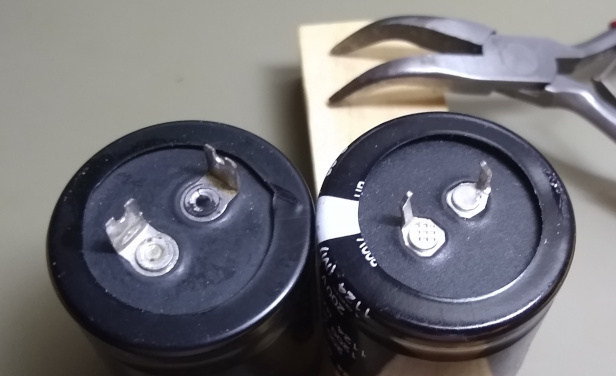Solution: @DJPhil@discuss.tchncs.de has made some really insightful comments below, which are really useful. If you just want the cap you can set the parametric searches for 660uF, or in September 2023 I’ve found that digikey stock(s/ed) chemi-con EKHJ451VSN661MA59M.
Update 2: Turns out that EKHJ451VSN661MA59M is not the ordering code you’ll want. That would be EKHJ451LIN661MA59M which returns 0 results when you Google it, or maybe a single result in a few days linking to this thread. So it looks like you’d be better off just getting some 680uF with blade snapins instead and retrofitting the board if possible. Just make sure it can handle the ripple current. Always check ordering codes twice my friends!
Original post
I need help identifying the terminals on some strange caps found in an AC inverter main board. The reason I state the AC part, is that the only other mention I’ve found of this layout, was a question on digikeys forum regarding an AC inverter https://forum.digikey.com/t/can-t-find-the-right-terminals-for-a-capacitor/19332 The capacitor in question has the same measurements as the one in the link.
In my picture on the right you can see the layout of the terminals, there’s room for three caps, but only two was mounted, hence the relatively clean pads. On the left is one of the two caps in question. It says nichicon LQ(K), 85°C. Nichicon has discontinued the LQ-series, and the datasheet doesn’t mention a 660µF variant. I don’t know what fujitsu did to get caps with capacitance outside the E24 series.
Question: What is the name of this type of terminals? And more importantly: where can you get 680µF 450V caps with them? I haven’t found them on neither Farnell or RS-Online.
For the sake of people googling this in the future, the AC in question is a fujitsu AOYS09LDC and the board was marked K05CM-C-A(03).


Hasn’t come up yet in a handful of tries over the years. The clamping force in the ones I was working with was insufficient to turn the rivet when the lead was rotated so I don’t suspect damage. The potted/sealed caps wouldn’t tolerate this at all, nor would any given particularly well riveted model. I totally understand not wanting to get weird with expensive parts. The one’s I was working with were only a few USD.
I figured I’d dig through the junk pile and see if I could demonstrate. On the left is an Elna CE-W series 470μF 200WV, Ø30mmx50mm I had lying around, probably from the late 80s/early 90s. These are likely from an old switching supply, back when they made them specifically for US 120V mains. Just included it for fun as I wasn’t sure I still had one around.
The one on the right is an unbranded 1200μF 200WV Ø30mmDx35mm with a 2011 datecode. I used the pliers in the background to give one of the leads a 90deg turn. It’s dodgy with such thin leads as these, but it can be done. Solder tie lugs are much better as they have a flat square lead shape that’s less likely to tear off. So definitely possible, but definitely dodgy.
I don’t always have the best ideas, but I do tend to have a lot of them. :)
I try to cast a wide net cause it’s not always obvious what priorities folks have in their repairs. I doubt anyone would care about the aesthetics, for sure, but you would get to do all your arts and crafts work without involving the board itself, which could make some folks nervous.
If you have time for the shipping you can get some Kafuter K-704N from aliexpress et. al. pretty cheap. It’s exactly the white selastic used for electronic holddown. Also the datasheet for whichever capacitor you order should have details for the recommended board footprint and drill size so you can be sure things will line up.
Glad to help :)
Thanks for all your input, it’s been fantastic. And the ideas thing? Right there with you pal.
For future reference, I found a source for the cap. Turns out that setting your parametric filter to exactly 660uF was the trick. Found chemo-con EKHJ451VSN661MA59M on mouser with a moq of “only” 200@12€… But digikey sells them individually at the same price.